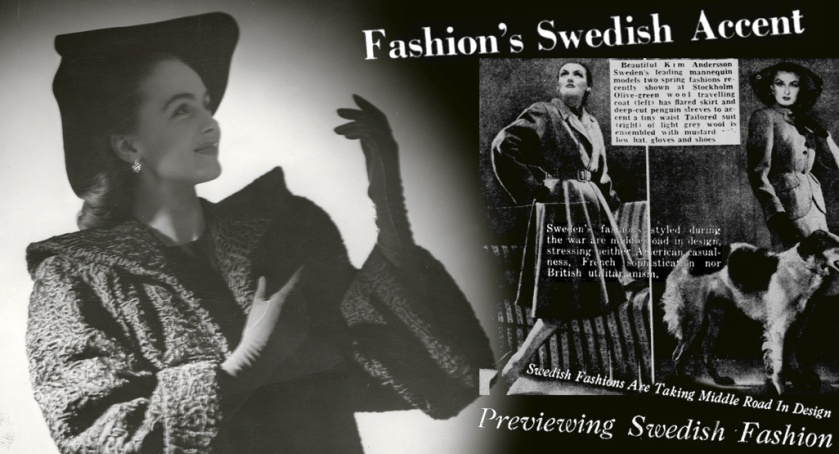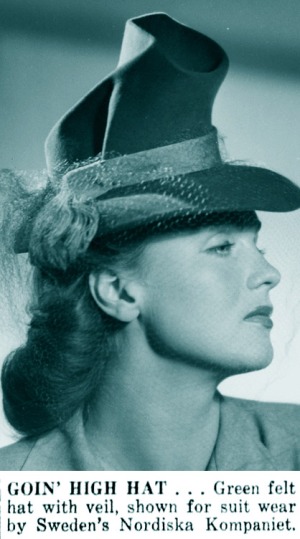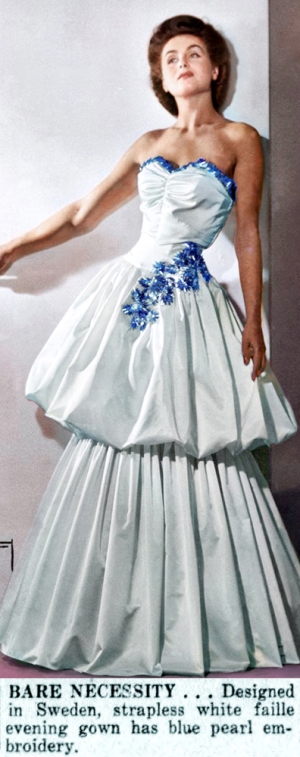
Paris was the undisputed centre of world fashion for years either side of the Second World War. Oleg Cassini went further: “At the time, it must be understood that Paris was fashion. Couture did not exist elsewhere.”
From 1943-1945, Hjördis Genberg cemented her position as Sweden’s leading model in the Nordiska Kompaniet’s flagship ‘Franska’ (French) department, which copied and adapted the latest Paris fashions for the high-end fashion market.
A (censored) message from Paris
In Ulrika Kyaga’s thesis ‘Swedish Fashion 1930-1960‘, she wrote that even while France was under German occupation, there were still regular columns in Swedish magazines devoted to the latest Paris fashions:
 “Until recently, a common perception among historians was that Paris was completely isolated during the occupation and that consequently no fashion information was spread outside of occupied France.” In other words, the likes of the Swedish fashion industry were forced to rely upon their own designers.
“Until recently, a common perception among historians was that Paris was completely isolated during the occupation and that consequently no fashion information was spread outside of occupied France.” In other words, the likes of the Swedish fashion industry were forced to rely upon their own designers.
This was only true to a degree. Certainly, there were new opportunities for home-based designers. However, fashion news still arrived from Paris, despite time delays and censorship while it passed through the German Information Bureau and the Berlin propaganda department.
“The Swedish fashion correspondent Ingeborg Markström, who was based in Paris during the war, confirmed that the Germans approved her right to cover the latest fashion news,” Ulrika Kyaga wrote. “She informed her readers how photographs, as well as entire articles, disappeared after being posted to Stockholm. She also explained how the Nazis removed all text containing Jewish as well as English family names.”
Swedish magazines featured a lot of home-designed fashion, which often reflected material shortages in the country, while readers were also exposed to American and British fashions through movies and celebrity news. The latest fashions from Berlin were also occasionally added to the mix.
Swedish dress patterns from the women’s magazine Vårt Hem. Late 1943 – early 1944
Triumph over shortages
 Outside reaction to wartime Swedish fashion was revealed in a syndicated American newspaper feature from July 1946. Photos of Hjördis, dating back to 1944, were chosen to illustrate. The commentary, which skimmed over circumstances, reflected on the mixture of styles:
Outside reaction to wartime Swedish fashion was revealed in a syndicated American newspaper feature from July 1946. Photos of Hjördis, dating back to 1944, were chosen to illustrate. The commentary, which skimmed over circumstances, reflected on the mixture of styles:
“Sweden’s fashions styled during the war are middle-road in design, stressing neither American casualness, French sophistication, nor British utilitarianism.”
Pictured left: Hjördis Genberg modelling for NK in 1944. Newly coloured using the description from US newspapers in 1946. Photo: Holmén, Erik / Nordiska museet
By the spring of 1947, Sweden’s latest designs, fronted by Kim Söderlund, were also displayed in US publications.
“Designers are proud of being able to originate their own fashions and claim they have nothing to learn from the US, France or England,” the NEA news agency reported. “Swedish-made accessories, however, are less inspired than those made in Paris. Moreover, the supply of ‘necessary little things’ that complete a costume is limited.”
“Although high-quality materials are still scarce in Sweden, the styles for spring reflect a triumph over fabric shortages.”
By November 1949, shortages had lessened. American visitors to Stockholm suggested that Swedish fashion design was coming closer to what they were familiar with at home, which was heavily influenced by Paris.
“The American influence on Swedish fashions is great,” journalist Treva Davis noted. “A fashion show at NK (Nordiska Kompaniet), the largest department store in Scandinavia, could have been a fashion show in any store in the United States except that the prices were in kroner. Several of the women reporters on American Overseas Airlines press flight to Scandinavia bought the clothes.”
“American in style, the clothes were made of British fabrics. There were also a group of copies of Paris fashions, which looked exactly like the Paris copies in America. It was also possible to see that Paris’s influence affected the American styles which had been copied by Swedish designers, and then became American influence. This proves something, possibly that fashion is international.”
Next page: Mrs Hjördis Tersmeden 1946

